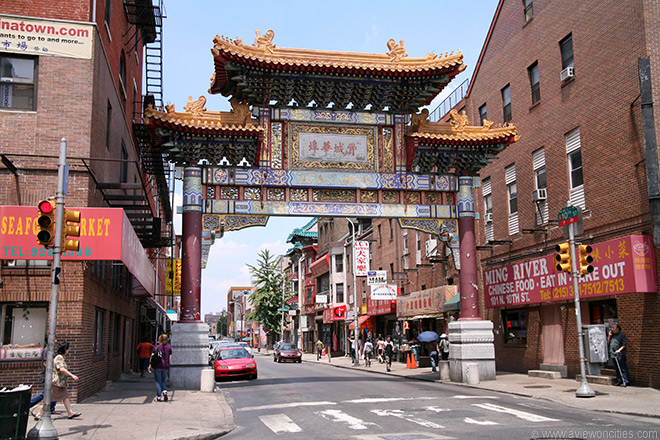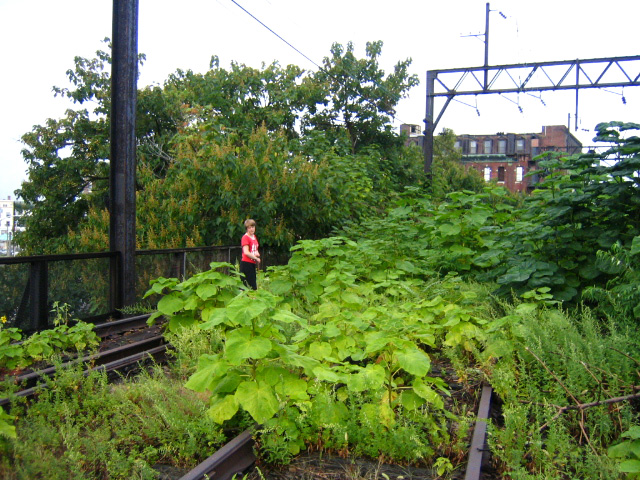
Chinatown Gate
photo credit:
www.aviewoncities.com

photo credit: nickcarey
Reading Viaduct

photo credit:
www.readingviaduct.org

The two spurs of the Reading Viaduct come together near Noble St. and eventually led into Reading Terminal
photo credit: egoldin

photo credit: ronin47
from here:
http://planphilly.com/node/9435
Discussion of the future of Chinatown North
July 23, 2009
By Kellie Patrick Gates
For PlanPhilly
Residents of Chinatown North gathered at the Theresa Hu Center Wednesday night to talk about the future of their neighborhood – the part of Chinatown split off by the Vine Street Expressway.
The discussion, sponsored by the Asian Arts Initiative and the Philadelphia Chinatown Development Corporation, hinged around a status report of the 2004 Neighborhood Plan for Chinatown and Callowhill, which was developed by the PCDC and John R. Gibbons, director of architecture for Kise Straw & Kolodner architects and planners after many months of community input. (KSK was hired by the Delaware Regional Planning Commission through a grant from the William Penn Foundation).
Based on the discussion last night, the community wants the same things it did then: Development that includes a significant amount of low-income housing. More green space and recreational opportunities for families. Education and help, including English language instruction, for immigrants. A wider variety of businesses.
And oh, how they wish the Vine Street Expressway could be capped.
Some of the things outlined in the plan have happened, or soon will, said Gibbons and PCDC Executive Director John Chin.
Many trees have been planted through neighborhood streets since 2004, and Franklin Square has been revitalized into a recreation space utilized by neighborhood residents and many other people. Many new homes have been built – most of them at market rate. Even more are planned, Gibbons said, but work has been slowed by the economy.
This year, work will soon begin on a small park with green space, benches, and pergola at 10th and Vine.
In March, improvements will start on 10th Street, from Race to Callowhill, to make it both more beautiful and safer, Chin said. This includes new sidewalks, lighting upgrades and more trees. Also to help pedestrians, more on-street parking was added along Vine Street as a way to slow down traffic, he said.
Another important element: Transforming the abandoned Reading Viaduct that crosses the neighborhood into a park, somewhat like New York City's High Line Park. This is one of the pieces that took a lot of discussion prior to the 2004 plan. In fact, there is still some disagreement about how much of the viaduct should be kept, and how much should be demolished.
A Commerce Department study found it would cost about $5 million to turn the entire length into a bare-bones park and $35 million to completely dismantle it.
The Neighborhood Plan calls for removing a section of the Viaduct, and creating a grade-level park. Gibbons said the removal would help provide space for high-density development where there would otherwise be irregularly shaped building lots.
But Sarah McEneaney, vice president of the Callowhill Neighbors Association and a founder of an organization that is trying to save the Viaduct, said the irregular lots would just result in buildings with character, and the Viaduct could serve as a link between neighborhoods. McEneaney brought up the Commerce Department study, and said it would be much cheaper to keep the entire viaduct.
Andrew Toy, a board member of PCDC, said that demolishing the section from Vine to Green would cost significantly less than demolishing the whole thing – between $11 million and $13 million. He said it took a lot of time to come up with the compromise in the neighborhood plan, and he was concerned that continued disagreement could postpone movement on the project.
An often heated Chinatown topic – the proposed Foxwoods Casino – did not come up until close to the end of the three-hour session, when one man asked through an interpreter what impact the casino would have on the long-range neighborhood plan. Another man added that he hoped that Spina would lobby for the plan if the casino would have a negative impact on it when the City Planning Commission reviews Foxwoods' proposal for Market and 8th.
The PCDC and Asian Arts Initiative representatives said they hope to keep the discussion going with future events. Spina said residents should watch for a City Planning meeting sometime this fall. The City is creating a new comprehensive plan, she said, and will hold meetings around the city to hear what residents want in their neighborhoods.